Have you ever wondered what it takes to create the perfect home for a ball python? These fascinating snakes have sweet personalities and beautiful color patterns. But, just like any pet, they deserve a comfortable and suitable habitat or enclosure to call their own home.
Keep reading to learn what’s required in preparing a ball python enclosure. But before that, we will examine the ball python’s natural habitat, which will inform some of our choices and decisions moving forward.
Quick List of Essential Ball Python Habitat Requirements
- Tank Size: (Minimum of 48″ x 24″ x 24″ for an adult (larger is better)
- Tank Type: Glass aquarium, PVC/plastic enclosure
- Substrate: DIY tropical mix (topsoil, ReptiSoil, play sand), cypress mulch, orchid bark, newspaper, or paper towels
- Heating: Basking spot of 95 degrees Fahrenheit; cool side should be 75-80 degrees Fahrenheit. Radiant heat panels and heat lamps provide heat.
- Thermostat: Essential to control heating elements safely.
- Lighting: Optional, but a full-spectrum fluorescent can enhance appearance. A 12-hour light/dark cycle on a timer is beneficial.
- Humidity: 50-60% generally. Increase to 70-80% temporarily during the shed. Misting and a humid hide box help.
- Hides: At least 2, ideally 3 or 4, placed at both warm and cool ends of the enclosure.
- Water Dish: Large enough for soaking is optional but recommended.
- Thermometer/Hygrometer: Digital versions for accuracy.
🐍 Further Reading: The Complete Ball Python Care Sheet
Ball Python Natural Habitat
The ball python habitat is native to range within West African coast and central Africa stretching roughly from Senegal to Sudan and Uganda. Most imported ball pythons hail from the countries of Ghana, Benin or Togo.
They primarily inhabit grasslands, scrublands, savannas and open forests. Ball pythons may also live in disturbed areas, around human habitations or farms. They do not typically inhabit rainforests (or other dense forests), nor do they live in deserts or extremely arid places. Ball pythons spend most of their time in rodent burrows, which provide them with shelter and moderate temperatures.
Ball Python Cage: What Type of Tank Is Best and What Size Should It Be?
The first thing you’ll need to provide your ball python with is a suitable enclosure. There are several different types of enclosure from which you can choose, and each presents different benefits and drawbacks.
The most commonly used enclosure types include:
Glass aquaria
Glass aquaria are readily available and typically quite affordable. They also offer unparalleled visibility, which will make it easy to see your pet. However, aquaria are quite fragile, and they can be difficult to move around. Additionally, glass aquariums do not retain heat very well.
For effective heat management in a glass enclosure, consider covering three sides with opaque material like construction paper to create a sense of security and make creating a temperature gradient easier.
Commercially manufactured cages
Commercially manufactured reptile cages are usually the best option for ball python keepers. Commercial cages are typically made from lightweight plastic like PVC or HDPE.. They feature front-opening doors are designed to accommodate heating devices, and hold humidity well… These cages come with a mesh top to offer better ventilation and secure lamp fixture placement.
It’s important to choose a front-opening enclosure, as this makes accessing your snake easier and less stressful for them. They are also more secure and reduce escape risks.
Plastic storage boxes
Plastic storage boxes can make suitable ball python habitats, and they are both affordable and lightweight. They’re also easy to find at big-box retailers and hardware stores. However, they don’t provide a good view of your pet, as they’re typically translucent (as opposed to transparent). You’ll also need to modify them by drilling air holes and making them escape-proof.
Custom-built enclosures
Custom-built enclosures are a great option for keepers who have the skill and desire to build them. However, they are usually best designed by keepers with a bit of experience, rather than beginners. Materials like sealed wood, PVC, and glass are popular choices.
Important Note: If using a glass enclosure with a screen top, always use lid locks. Ball pythons are escape artists! Avoid using tape to secure lids, as it poses a significant injury risk to your snake
Enclosure Size and Dimensions
No matter what type of enclosure you select, you must ensure that the length of the enclosure should be at least equal to the length of your snake. This gives your python the room it needs to stretch out fully.
Habitat size is a hotly debated topic among keepers, but generally speaking, an adult ball python approx. 3 feet will typically need an enclosure measuring at least 48″ x 24″ x 24″. Also, 8 square feet of floor space offering at least 2 feet of vertical space allows for beneficial climbing opportunities, with more height being even better – this is especially important for males.
A hatchling of 300g would thrive in a 10-gallon sized enclosure or a tub with approximate measurements of 20″ x 11″ x 13″. Juveniles under 3 feet in length typically do well in enclosures measuring 36″ x 18″ x 18″ or larger. They can even be housed in their long-term adult enclosure provided there is plentiful cover and ample hiding spots.
🐍 Further reading: Can Ball Pythons Live Together?
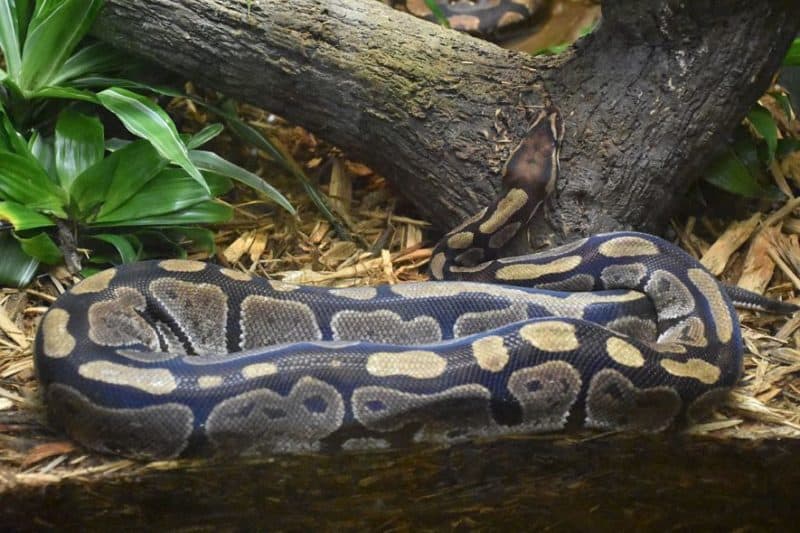
Ball Python Enclosure: Providing the Proper Lighting and Temperatures
Now that you’ve selected an enclosure for your ball python, you must provide proper temperatures and lighting for the habitat. Generally speaking, it is quite easy to provide lighting for a ball python, but you may need to make repeated adjustments to establish the correct temperature range for your pet.
Ball Python Habitat Lighting
Ball pythons – like most other snakes – will remain healthy and happy without any specialized lighting. The ambient light entering their enclosure will provide all the light they need. In fact, ball pythons are primarily nocturnal, so extremely bright lighting will often cause them to hide.
However, you can help your snake look his best by incorporating a full-spectrum fluorescent fixture over the habitat. You needn’t use a light that provides UV radiation; simply choose a light that provides a well-balanced color spectrum and a moderate light intensity.
Be sure to plug the lights into a timer so you don’t have to worry about turning the lights on and off every day. This will also provide the snake with a consistent light-dark cycle, which is important for your pet’s health. A 12-hour cycle (12 hours of light, followed by 12 hours of darkness) works well, given the species’ equatorial distribution.
🐍 Further Reading: Ball Python Lighting Needs and Requirements
Ball Python Habitat Temperatures
Ball pythons prefer relatively high temperatures, like those in their natural range. However, you should always provide snakes (and other reptiles) with a thermal gradient. This will allow them to access a range of temperatures at any given point in time.
To create a thermal gradient, you’ll need to place all of the heating devices for the habitat at one end of the enclosure. This will create a basking spot, which provides the warmest temperatures in the habitat. Ideally, the temperatures at the basking spot should be about 95 degrees Fahrenheit during the day.
The opposite end of the habitat should provide somewhat cooler temperatures. Temperatures onin the cooler side should below- to mid-75-800s Fahrenheit isare ideal. Just be sure that they are below 80 degrees so that your snake can cool off if necessary. The temperatures between the basking spot and the cool side of the enclosure will decrease with increasing distance from the heat source.
You can use heat lamps, heat tape, heat pads or radiant heat panels to supply the heat for your pet.
Personally, I’ve always preferred overhead heat sources, such as lamps and radiant heat panels. Overhead sources reduce the likelihood that your snake will suffer burns, and they’re probably better from a fire-safety perspective.
However, other keepers prefer the convenience heat pads or heat tape provide. Just be sure to monitor the temperatures provided by these types of heat sources. It’s also important to follow all of the manufacturer’s instructions during installation.
Unless the temperatures in the habitat fall below about 68 to 70 degrees Fahrenheit at night, you can simply turn off the heat sources overnight. If you need to provide supplemental heat at night, do so with heat sources that do not produce light.
🐍 Further Reading: Ball Python Temperature & Humidity Needs and Requirements
Suitable Humidity for a Ball Python Habitat
Snakes need suitable humidity levels to remain healthy. If kept too dry, they’ll have difficulty shedding properly, and they may become dehydrated. On the other hand, snakes kept in excessively humid environments may develop potentially fatal skin diseases. Improper humidity in either direction may also cause the development of respiratory infections.
Ball pythons typically prefer a relative humidity of 50% to 60%. That’s a bit damper than the air in most homes, so you’ll likely find it necessary to mist your pet’s habitat lightly with room-temperature water each day. You can also add water to the substrate or increase the size of the water dish to raise the humidity.
It’s also a good practice to provide your ball python with a moist hide box (in addition to his normal hide box discussed below). This will help prevent dehydration and give him a good place to sleep when he is entering a shed cycle. This will help promote full, problem-free sheds.
You can make a humid hide box by adding a bit of damp (not wet) moss or mulch to a small container. Just cut a small door in the side of the container to provide your snake with access to the retreat.
During the shedding cycle, aim to temporarily increase the humidity in your snake’s enclosure to around 70-80%. This aids in a complete and healthy shed.
If your ball python’s habitat is too damp, you’ll need to try to reduce the humidity and dry the cage out a bit. The best way to accomplish this is by increasing the amount of ventilation provided. You can also try decreasing the size of the water dish. Invest in a hygrometer to measure humidity levels accurately and place it in the middle of your ball python’s enclosure.
🐍 Further Reading: The Ball Python Behavior & Health
Bedding: What Is the Best Substrate for a Ball Python Enclosure?
There are a variety of different substrates you can use to maintain a ball python. No single substrate is ideal for all situations, so you’ll need to compare the options available and select the best choice for you and your pet.
Some of the most common ball python substrates that can be used include:
DIY Tropical Mix
A combination of organic topsoil (40%), Zoo Med ReptiSoil (40%), and play sand (20%). This mix offers excellent affordability and humidity retention. Layering with sphagnum moss and leaf litter enhances its effectiveness.
Cypress Mulch
Cypress mulch is another great choice, and it is the author’s favorite substrate for ball python maintenance. This mulch is very affordable (although the price varies by geographic region), permits burrowing and retains moisture well, which can make it easier to maintain the proper enclosure humidity. Cypress mulch also smells nice.
Orchid Bark
Orchid bark is somewhat similar to cypress mulch in that it is helpful for maintaining a high humidity level. It also looks great and allows snakes to burrow. However, orchid bark is often relatively expensive, so it isn’t commonly used in large enclosures.
Newspaper
Newspaper is probably the simplest, most hygienic and most affordable substrate you can use. It is easy to replace when soiled, and your snake can even crawl under the newspaper to hide if he wishes. Generally speaking, newspaper is the best choice for novice snake keepers.
Paper Towels
Paper towels provide most of the same benefits that newspaper does, and it is also a good choice for beginners. It can be difficult to use paper towels in adult-sized enclosures, but it works very well in the relatively small habitats used for hatchling and juvenile snakes.
Just be sure to weigh the pros and cons of these substrates before making your choice. However, you can always decide to make a change later, if you determine that your first choice isn’t working well.
Bad Substrates (Avoid These)
- Reptile Carpet: Difficult to clean properly and doesn’t handle messes well.
- Aspen Shavings/Chips: Prone to rapid molding in humid environments.
- Pine/Cedar Shavings: Potentially harmful due to oils that may cause neurological issues in reptiles.
🐍 Further reading: Best Ball Python Substrates and Beddings
Additional Accessories and Supplies for Your Ball Python Cage
In addition to heating and lighting devices and an appropriate substrate, you’ll need a few more things to turn your ball python’s enclosure into a suitable habitat.
- All ball python enclosures must include at least one hide box, and it is preferable to include several. Failing to provide your snake with a good place to hide will cause him a great deal of stress. It is also likely to suppress his desire to feed. An inverted plastic tub with a door cut into the side is ideal, but there are also commercial options available.
- You’ll also need to add a water dish to the enclosure and keep it filled with clean water at all times. You can use a plastic water dish, but glass, ceramic or stainless-steel dishes are preferable. The dish needn’t be large enough to permit your snake to soak, but you can provide a dish large enough to accommodate your snake’s entire body if you like.
- You can add plastic or real plants to the enclosure if you like, but they aren’t necessary. Plastic plants are safer and won’t require any care, but some keepers prefer the look of live plants. Just be sure to avoid toxic species or those that are armed with thorns or spines.
- You must also obtain a high-quality digital thermometer to monitor the ambient temperatures in the habitat. In fact, it is also wise to purchase a non-contact infrared thermometer, so you can also monitor surface temperatures in the habitat.
> Further Reading: The Ball Python Diet
Now It’s Your Turn
As you can see, it isn’t terribly difficult to provide a ball python with a proper habitat. Just be sure to start with a suitably sized enclosure, heat the habitat appropriately and choose a good substrate. Add a few hiding boxes, a water dish, and a digital thermometer and you’ll have a habitat that’ll keep your ball python healthy and happy for years to come.
I’d also offer a bit of personal advice to new keepers:
Although many new keepers are eager to create a beautiful, intricately decorated habitat for their pet, it’s probably wise to start with a very simple enclosure. Don’t get me wrong – I love setting up complicated and elaborate vivaria for ball pythons (and other snakes), but I see a lot of new keepers make mistakes when doing so.
Instead, I recommend that first-time snake keepers maintain a simple and straightforward habitat for six months to a year before setting up a natural-looking vivarium. This will give you the chance to learn the basics of habitat design and maintenance, which will help you avoid a number of common problems.
We hope you’ve found this guide helpful and would love for you to share it with your snake-keeping friends if you enjoyed it.

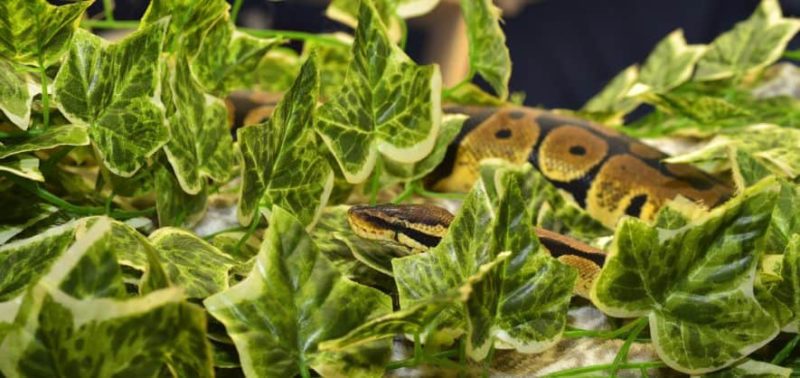






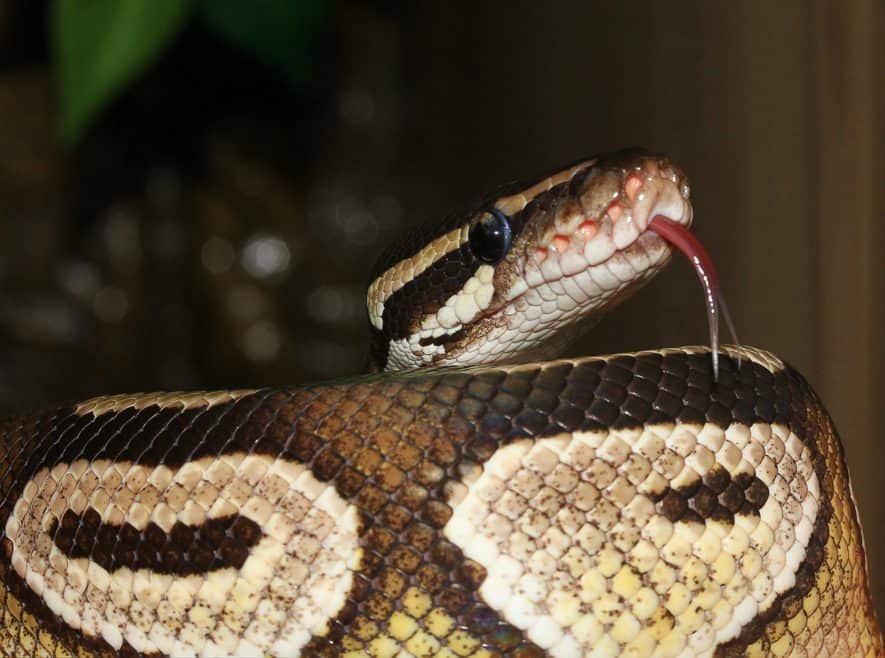
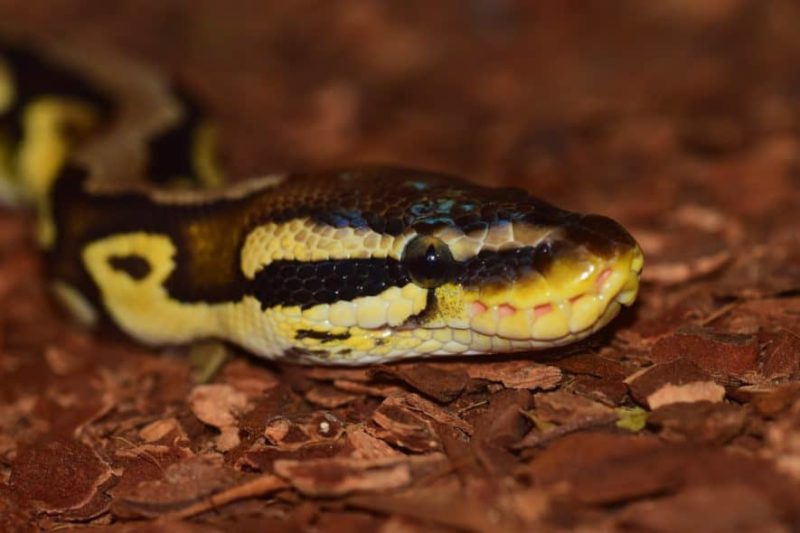
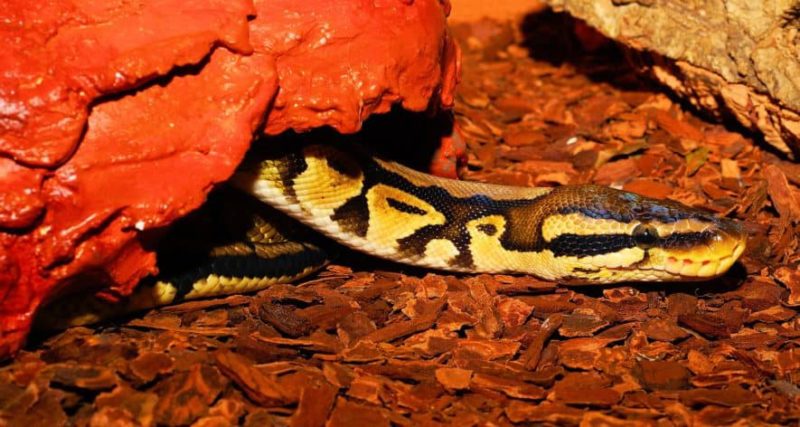
55 Comments
We are worried about our new Ball Python
It hasn’t ate since we got it and today will mark the 8th day of having it and not eating. Is this ok?
Hi Anne,
It is relatively normal for a python not to eat for a while after being relocated, pythons can go for several months without eating. Double check that your setup is correct, especially your temperatures and make sure your python has plenty of places to hide. Make sure you are trying to feed it the same food item that it was being fed before you took it home. Double check that no other pets are bothering your python and that it is not in a very high traffic part of your household. Weigh your python, if he starts to lose weight then please let me know.
Thank you so much for all of your great information. I have a ball python that’s a little bit over a year old with a correct set up like you’ve explained.. however I cannot seem to get him to eat he stopped about two months ago and I’ve probably introduced for rats and he has not taken any interest in them I’m worried. I did notice that he had some eye caps from some shed that did not come all the way off so I did remove those I’m just curious from your professional opinion have you ever seen ICaps make a snake not interested in eating
Hi Brittany,
I’m glad you like the article. There can be a number of things that cause your ball python to stop eating. Iif it is the switch from mice to rats then perhaps for now put him back on mice. Sometimes you will need to rub the smell of the mice onto the rats during this change in food item. Weigh your python weekly, if he is not losing weight then I would not start to panic yet. Many snakes stop eating during the winter months and retained shed can indeed stop a snake from wanting to eat. Do you have a moist hide inside your enclosure?
I like that you highlighted the fact that lights are NOT needed! I think you should also mention reptile carpet for a suitable substrate though. My BP had trouble eating in aspen and mulch because she would get it in her mouth when she struck and then drop her prey. She’s a little derpy, but reptile carpet works perfect for her. I have also used that thick brown painter’s paper too, but prefer to wash the carpet rather than throwing out paper because it’s less wasteful.
I have my BP in a 18x34x9 acrylic case from reptilebasics.com with no lights and reptile carpet, heat mat on one side with thermostat, maintains about 95-97 degrees, and a large heavy water bowl on her cool side that gets down to about 74-76 degrees. I measure temps with a digital thermometer gun.
She moves her hide around actually, but prefers it mostly on the warm side, slightly in the middle. She is very happy in her warm dark environment, and always has perfect sheds – the short enclosure and big water bowl is perfect for humidity needs, but if she’s taking a little longer to shed I give the inside a spritz daily for a few days which helps. She consistently eats one F/T gerbil a week, healthy eater, shedder, pooper, such a good girl!
I really do like your “less is more” position and couldn’t agree more!
Thanks, for the post that was really great info.
Just checking if this is still an active thread? I just picked up a BEL and he’s gorgeous, I know how to maintain and care for my BP but this seems to be a great site.
I’m a zookeeper, so I have some professional experience with snakes, but I’m just starting into the world of personal snake keeping. Do you recommend a quarantine type tank if this is your only reptile? Also, do you have any recommendations for plant species that are safe for a ball python habitat? I would love a more natural set up for a tank.
Hi Leah,
My favourite style of tank are the plastic ones with sliding glass doors at the front. These tanks are generally opaque on all sides apart from the front which helps the snake to feel more secure. Having doors at the front makes the tank easier to clean and also helps with handling. Birds are a main predator of snakes in the wild so coming from above is never good. You can keep live plants in your snake’s enclosure, it does however make keeping the humidity level correct and cleaning more difficult. For a ball python enclosure I would recommend Golden Pothos (Epipremnum aureum), Boston Fern (Nephrolepis exaltata), Urn Plant (Aechmea recurvata), Elkhorn Fern (Platycerium bifurcatum), Spiderwort (Tradescantia zebrina) and Heartleaf Philodendron (Philodendron hederaceum) to name a few.
I have had my BP for 19 years. I believe he was 1 or 2 when I got him. I am no stranger to how stubborn they can be about not eating (especially in the winter time). Vinny hasn’t eaten since October 12. I go to my pet store every 2-3 weeks. In September, he was eating adult rats. About 2 months after he stopped eating, I started getting him smaller and smaller prey.
Am I doing something wrong? Is he coming to the end of his life?
Hi Eric,
The average lifespan of a ball python is around 25 years, however, they have been known to live almost twice as long, whilst he could be coming to the end, it is common for snakes to refuse food for up to around 6 months. Double check your temperatures and humidity and make sure you are defrosting the food items correctly. Try feeding at dusk and leave the food item in his enclosure overnight. If he is not losing weight, I would not start to worry too much until you come up to the 6 month mark. If he begins to lose weight or goes this long without food, take him to see the vet. Has anything changed in your household, new pets etc?
I want to incorporate live plants in Ali’s terrarium, my question is what substrate should I use that will be healthy for Ali and grow the plants in? Also what kind of isopods should I get
Hi Tami,
Live plants can certainly be added to Ali’s terrarium, however, bear in mind that it will make cleaning the enclosure and keeping humidity constant harder. I would use coconut huss or unfertilised potting mix for the plants, then top it with orchid bark. I wouldn’t add any isopods as this could introduce parasites, bacteria or fungus into the enclosure.
We have had Cyphur for 8ish years he is approx 18 years, 10 years when rescued. Love the snake. Recently set up a vivarium for him. You indicate not to introduce isopods but told by reptile store we go to that we should introduce isopods, and also springtails. We have live plants and is 80 gal glass aquarium. My daughter is concerned about a repertory infection as not all the time but when yawning has blown bubble. he is in winter sleep mode now. She now thinks we should have had activated charcoal in the gravel base as well. Gravel, mesh, sterilized soil, and bark, in that order now.
Hey Joop,
There is no definitive answer on whether or not to introduce isopods and springtails into a vivarium for a snake, as it depends on the individual snake’s preferences and needs.
However, if your daughter is concerned about a respiratory infection, it might be worth considering activated charcoal in the gravel base, as this can help to absorb any potential toxins or bacteria in the air.
I hope this helps. Thanks
Hi! Not sure if this question will make sense or not but will making my tank more “full”, such as putting more hides and branches and things like that, keep my snake warmer when temperatures drop at night?
Hey, Lauren.
Totally makes sense! In actuality, keeping more dense objects in the enclosure will keep the temperatures from falling as much at night. This is often referred to as adding more “thermal mass” to the enclosure.
However, I don’t know how much hides or branches would work. Usually, keepers trying to incorporate more thermal mass will add things to the habitat like bricks, stones, or maybe large water dishes.
Best of luck!
If I get a juvenile snake can I just block out a section of a larger tank until they reach maturity? Or can a juvenile thrive in a larger than recommended enclosure?
Hey there, Saoirse.
That would work! But, if you add enough plants/branches/hides and other visual barriers, you wouldn’t even have to. Snakes can become stressed by living in habitats that are too large and empty – they don’t have a problem with large cages that have lots of “stuff” in them.
Best of luck!
How do I determine the size of enclosure needed. Im building a custom terrarium in an old corner cabinet but was told to consider more floor or foot space than when I have to provide. My ball is currently about 30″ at 3 years old and not growing as much as I’d expected. The base of me enclosure is roughly 36″ by 21″ but 48″ tall. Its an old corner curio cabinet. Does it need a broader footprint or floor base?
Hey, Anthony.
That sounds like a reasonable footprint for his habitat. Ideally, it’d probably be a little bigger, but that doesn’t sound like you’ll be unfairly confining him.
Best of luck with your project!
thanks for the information
Our ball python is 16 years old this year. On nice warm days she gets to hang out in our backyard large maple tree. I wrap her around my waist & take her to visit friends and relatives.
If you are using an undertank mounted heat pad, where is the best location to put the hide for the snake? should the hide be placed on the warm side of the tank or the cool side of the tank? I understand from a lot of research that most recommend placing the water on the cool side of the tank, but not a lot of places give a good break down for placement of hides.
Hey, Pamela.
In a perfect world, you’d use two hides and place one at each end of the enclosure. This way, your snake doesn’t have to choose between his preferred temperature and security.
If you are forced to choose one though, I’d recommend putting it on the warm side.
Best of luck!
what are your thoughts on making a small pond like structure with a small waterfall
what your thoughts on a small water structure and small waterfall
Hey, Brian.
You’re welcome to try, but it’ll likely prove to be a ton of work. Just be sure that you keep the water clean and make sure that the pump’s power cords don’t create a gap in the habitat through which your snake could escape.
Best of luck!
Although helpful I still have specific questions. What lighting exactly provides heat? I have a red bulb but can’t seem to get the heat up in the cage. Not knowing I had a heat mat in the glass aquarium and am now dealing with a burnt belly. So exactly how do I provide suitable heat?
Hey, Charlotte.
Just about any incandescent bulb will provide a significant amount of heat. You may simply need to experiment with different wattages or adjust the distance of the bulb to the habitat.
In some cases, a 25-Watt bulb may provide sufficient heat, but in other cases, you may need a 150-Watt bulb or more. You’ll just have to breakout the thermometer and start experimenting.
Heat pads and other non-light-emitting heating devices should always be used in conjunction with a thermostat to avoid burns.
Best of luck!
Wow thank you for this, I’m New to the world of reptiles and I really appreciate all of the info! Keep doing what your doing! 😀
My snakes is a few months old it has not eaten in almost 4 weeks. Because her humidity has been high. Any suggestions?
Hi Heidi,
I would recommend lowering the humidity in her enclosure. Try aiming for a relative humidity of 50% to 60 %. If she is still having trouble eating, please bring her to the vet.
Thank you!
Does it hurt to offer ball pythons a climbing structure?
Not at all, Riccardo! Ball pythons aren’t a species that *requires* climbing opportunity, but many will climb if given the opportunity to do so. Just be sure that you mount the branches safely, so your pet doesn’t fall and injure himself.
Thanks for reading!
My BP wants to wrap around the temp gauge and he has fallen off of it a couple times..will that him him and what can i do to keep him from doing so? Also he hasnt shed in his new tank and i read that the tank can be too “open” and cause distress…do you recomend covering the backside and sides to make it more ” closed”?
Hi Sandra,
A small drop won’t do him any damage but make sure he has other options to climb. The move to a new tank can definitely cause him some stress, make sure he has adequate hiding places, check your humidity and temperatures too. I generally prefer tanks that are not open all the way around so yes you could try blocking off the back, sides and top, leaving just the front open.
Overall, this is a pretty great care guide! But there are some things that I’d like to point out. Firstly, the temperatures are a little off. The warm ambient temperature of the enclosure should be from 90 to 94 degrees, and the cold ambient should stay at 78 to 82 degrees. 70 is a tad too cold. It is stated in this article that climbing enrichment is not required for ball pythons, but that I believe is false. Ball pythons have been observed climbing trees in the wild, and they benefit greatly from climbing space. An extremely important thing that was left out in this care guide that is possibly the most important, a thermostat. With any heating device, whether it be a ceramic heat emitter or a heat mat, you need a thermostat, and it is not optional. You don’t prevent burns (which are shockingly common) by monitoring the temperatures, as you cannot control a heating element’s temperature without a thermostat. A friend of mine conducted an experiment, she ran various types of heating elements for a couple hours, all without thermostats, and measured the surface temps of each element. The mat got to 123°F, and the ceramic heat emitter got to 148°F. I have pictures to prove this if necessary. That can kill even the most heat resistant snake in a matter of minutes. You can find thousands of dead or injured snakes online with extremely serious burns because of beginners who do not use thermostats. This is also why you shouldn’t use heat lights with any snake, as the thermostat turns it off when it gets too hot. Having the light flicker on and off constantly will stress out your snake. Regarding the feeding guide for Ball Pythons, the feeding instructions are also considerably off. A hatchling ball python is big enough to take fuzzy rats after their yolk sack is absorbed and they have their first couple meals, and by the time they are a year old they are big enough to take small rats once a week. And adult ball python is going to need a medium to adult rat once every 2 to 3 weeks, depending on their body condition and size. The prey item should be a bit bigger than the thickest part of their body. Ball pythons quickly outgrow mice, and mice hold less nutritional value than rats. I’ve seen many underweight snakes due to them being fed extremely small mice for their size, as opposed to an appropriately sized rat. And lastly, I do not recommend aspen for ball pythons at all, nor do I reccomend using a completely barren enclosure for the first six months to a year. Aspen holds virtually no humidity, and I’ve seen extremely dehydrated snakes that were on the verge of death because they were on aspen with very high heat. Stuck shed on their entire bodies. Ball pythons do not do well with barren enclosures for long term. A quarantine enclosure (2 hides, 1 water dish, paper towel substrate) is ideal for no more than one month to check for illnesses. Ball pythons specifically are very shy and temperamental, they will stress and refuse food if there isn’t enough cover in the enclosure. There are some other things I’d like to point out, but I believe I got the majority down here. I appreciate you reading this, and have a wonderful day!
Hi, Alivia. Thanks for your comments, but I stand behind the advice provided.
A couple of things:
The temperature range I described is accurate. Surface temperatures in the mid-90s are ideal, while ambient temperatures in the mid-90s may prove too warm in some cases — particularly for fledgling keepers.
Additionally, 70 degrees is perfectly fine for the cool side of the habitat. It’s not always possible to achieve such a drastic gradient, but it is a worthy goal. I’ve routinely dropped ball pythons to the mid-60s at night during breeding trials. I wouldn’t recommend beginning pet keepers do so, but experienced keepers often have success with this approach.
You’re certainly welcome to offer your ball python climbing branches, but they do not require them in the same way that Morelia species and some others do.
You do not need a thermostat with all heating devices — specifically lights. In fact, I typically recommend that beginning keepers use lights, as they’re considerably safer and easier for beginners to adjust than pads or panels. However, it is imperative that keepers monitor temperatures consistently to ensure the heating devices are operating properly. Thermostats should not typically be used with lights, but I’ve seen experienced breeders (including the world’s leading producer of green tree pythons at the time) use them without issue.
The food guidelines are designed to offer beginners a good starting point. Hatchlings are often capable of consuming rat pinks/rat fuzzies, but small mice are typically better for beginners to offer. Snakes occasionally injure themselves (sometimes severely so) by trying to consume prey items that are too large. And because this is a brief article providing instruction to beginners, it is better to err on the side of caution.
I would also point out that statements like “mice hold less nutritional value than rats” are so vague that they’re not helpful at all. I know these kinds of statements are bandied about on message boards, but the truth is far more subtle. Moreover, it is advisable to provide snakes with prey items that have fully formed skeletons.
The quarantine protocol I described is similar to that employed by zoos and professional keepers across the country.
Aspen is perfectly suitable for ball pythons in many cases, provided that their temperature, relative humidity level, and water reservoir are properly maintained. Personally, I prefer cypress mulch, but I’ve used aspen hundreds of times.
I realize that you’re probably trying to help, but I have more than 20 years of experience working with this species, I’ve produced somewhere in the neighborhood of 10,000 captive bred herps, and I’ve authored more than 40 books about reptile care (including one on ball pythons).
Nevertheless, I appreciate you reading and sharing your thoughts!
Thank you for this helpful article! Greatly appreciated!
I loved this care sheet! The person who posted above may have been trying to help but they sounded like they were only trying to prove you wrong and they didn’t give any sources to back up why they think they’re right. And you handled their post very diplomatically! I have used the same Temps and aspen is fine. Their natural habitate is dryast of the year and they hidrate them selves by finding moist places to hide in. Like termite mounds. Thanks for your informative care sheet! I have two and I am very interested in and researching how to start a vivarium!
thanks ben for all the information given, this was much needed, so sick of all the know it all’s.
my setup is almost to the T of what you said and I have been so scared that I been doing it wrong listening to all the other crap, from now on I’m just gone come here. Thanks again
Hi Nancy,
I’m really glad you liked Ben’s article and I understand your struggle, there is an awful lot of misinformation and contradicting articles online. Please let me know if I can help in any way.
Thank you so much, I got up at 3 this morning and Royalty my python was shedding, it was so perfect. I did exactly what ben said . When I saw that she had turned blue, I start adjusting her humidity from 50 to 60 up to around 75 and 80. OMG it was the most beautiful sight ever. Thank you for everything!
Hi Nancy,
Great, I’m glad that Ben’s information was able to help your pythons shedding cycle. Usually a moist hide is enough to assist with shedding but in some cases an increase in humidity is required. Be careful with increasing the humidity too often or for extended periods of time as this can have an adverse effect such as scale rot.
Thermostats are essential !
Thank you for this very informative and concise article.
Thank you
A lot of information about the questions I had. Looking forward for my snake baby,but still need more,and more.
🐍🐍🐍
I’m the owner of 5 Ball titans I have a bumblebee python who just strikes no matter what eats well but it’s very aggressive why is this
Hey Jrbreda,
It is common for aggressive behavior to be seen in captive bumblebee pythons. There are a few potential reasons for this, including:
1) Poor captive husbandry conditions – Bumblebee pythons are native to Australia and require specific temperature and humidity conditions that are often difficult to replicate in captivity. If these conditions are not met, it can lead to stress and ultimately aggression in the snakes.
2) Defense mechanisms – In the wild, bumblebee pythons are often preyed upon by larger predators. As a result, they have evolved to be very defensive and aggressive to protect themselves.
3) Natural aggression – Some snakes are simply more aggressive by nature and this is something that cannot be changed.
If you are concerned about your bumblebee python’s aggression, the best thing to do is consult with a reptile veterinarian or experienced reptile keeper for guidance.
Thank you
You say ball pythons don’t like to climb. I have 2 of them and they love to climb. They are incredibly active creatures and they climb all over their enclosures almost every night. I find I have to take them out and put them on the stairs to let them burn off some of that energy